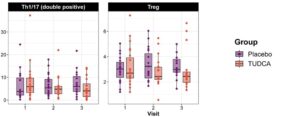Linh Le, et al. – University of Rochester.

Background: The locus coeruleus (LC), which produces noradrenaline (NA), is one of the first brain regions to experience neurodegeneration in AD, yet how this loss affects AD pathology remains largely unknown. Previous work has found that microglia express particularly high levels of the β2 adrenergic receptor (β2AR) and that NA signaling in vitro reduces microglial inflammatory responses.
This Study: Le and colleagues examined changes to the LC, NA signaling, and microglia in the 5xFAD transgenic mouse model.
- Reduced cortical NA signaling precedes neuronal loss in the LC due to early damage to the LC nerve fibers innervating the cortex.
- A region exhibiting early amyloid pathology (anterior cingulate cortex) showed breakdown of these fibers earlier than a region that develops amyloid pathology later (V1).
- Microglia associated with amyloid plaques have severely reduced expression of β2ARs, while plaque-distal microglia show a less severe reduction early in the disease time course that worsens over time.
- Genetic and pharmacological blocks on β2AR signaling worsened amyloid pathology, while chronic β2AR stimulation prior to the onset of pathology reduced it.
Bottom Line: Reduction in NA signaling from LC is linked to increased microglial inflammation and exacerbated amyloid pathology.
Open Question: The breakdown of fibers from LC in the AD mouse model is an acceleration of the breakdown observed in WT controls, rather than a phenomenon entirely unique to AD. If AD pathology is linked to this breakdown, could it be that AD risk genes known to affect microglia leave them more primed for an inflammatory response, and thus cause more damage in the absence of inhibitory NA and presence of plaques?




